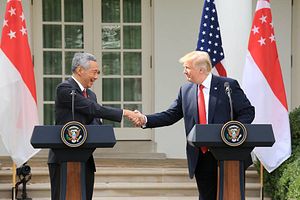On Monday, Singapore’s Prime Minister Lee Hsien Loong held a summit meeting with U.S. President Donald Trump, becoming the fourth Southeast Asian leader to do so less than a year into a new U.S. administration as Trump prepares for his own inaugural Asia voyage in early November (See: “What’s Next for US-Singapore Ties Under Trump?”). Though much of the commentary around the trip tended to emphasize its economic aspects, defense ties were also an important area of focus as well.
As I have written before, the United States and Singapore have long viewed each other as vital strategic partners, and that extends to the defense area as well. The United States is a key supplier of defense technology and facilities for military training for Singapore, while the city-state is a valuable regional partner across a range of issues from counterterrorism to maritime security, while also hosting a U.S. Navy logistics command unit that coordinates regional operations (“Strengthening the U.S.-Singapore Strategic Partnership”).
In 2015, during the Obama administration, the two countries had inked an enhanced defense cooperation agreement (DCA), with a broad framework covering five areas of collaboration in new areas including cybersecurity, biosecurity, and public communications. There have been other significant developments since then as well, from the deployment of U.S. P-8 Poseidon spy planes and littoral combat ships (LCS) to Singapore to the launch of a new bilateral maritime exercise off of Guam called Exercise Pacific Griffin (See: “What’s in the New US-Singapore Maritime Exercise in Guam?”).
This time, Lee’s visit unsurprisingly saw a heavy emphasis placed on the economic dimension of ties. Apart from the fact that Singapore has traditionally been a key partner for the United States on trade and investment issues and has been worried about the U.S. withdrawal from the Trans-Pacific Partnership (TPP) trade agreement, the $13.8 billion dollar deal for Singapore Airlines to buy Boeing jetliners, which was said to produce 70,000 jobs, no doubt provided Trump an opportunity to signal that he was making progress on his “America First” agenda with the city-state’s help.
That said, defense issues were also part of the conversation. At the joint press conference, Trump cast this rather broadly, in terms of the two countries’ “unwavering commitment” to countering the North Korean threat and promoting freedom of navigation in the South China Sea – a rather blunt characterization that obscures the nuances of the city-state’s actual positions –as well as Singapore’s role in recent developments like the tanker collision involving the USS John McCain in August and relief operations after Hurricane Harvey (See: “What Did Singapore’s Latest US Military Helicopter Deployment Achieve?”). Of course, as I have noted before, equally important are the regular interactions both sides have, including exchanges, visits, and training.
As anticipated, the headline item during Lee’s visit on the defense side was his announcement on the extension of Singapore’s commitment to U.S.-led efforts to defeat the Islamic State. That came as no surprise. Singapore was the first Southeast Asian state to join the U.S.-led Global Coalition to Counter ISIL (ahead of Muslim-majority Malaysia) and had already been involved in several important ways, including in air-to-air refueling, image interpretation, and intelligence gathering and coordination in the Middle East (See: “US To Host Counter-Islamic State Meet Amid ASEAN Terror Fears”).
Indeed, during his last visit to Washington D.C. in 2016 under the Obama administration, Lee had announced that Singapore would deploy a medical team to Iraq as part of its ongoing contribution to the battle against the Islamic State, which was later detailed by Defense Minister Ng Eng Hen. Last month, Ng, along with other Singapore officials and SAF officers, visited the SAF medial team deployed in Iraq.
While Lee was in Singapore for his meeting with Trump and other administration officials, Ng also met U.S. Defense Secretary James Mattis on the sidelines of the 11th ADMM and 4th ADMM Plus held in the Philippines. Unsurprisingly, though they touched on bilateral ties and issues of regional and global interest, the terrorism threat was part of the conversation too (See: “ASEAN Defense Meeting Puts Terrorism in the Spotlight”).
According to Singapore’s defense ministry (MINDEF), Ng said that Singapore would look to continue its contributions to the U.S.-led coalition to defeat the Islamic State, including contributing an imagery analysis team, a medical team, and a KC-135 tanker aircraft. He also said that Singapore would look to help facilitate some of the counterterrorism initiatives that had been discussed in recent U.S.-ASEAN defense meetings as the holder of the ASEAN chair for 2018.

































